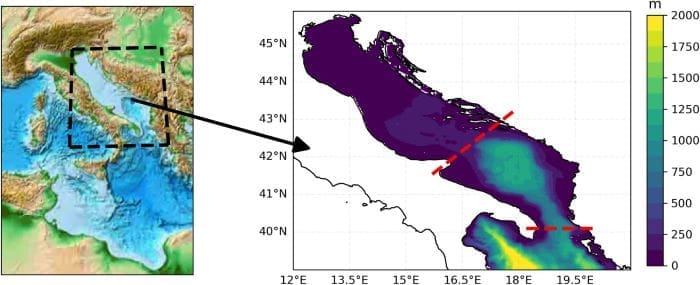A comprehensive analysis of the Adriatic Sea’s climate indicators has provided new insights into the region’s ocean dynamics and the impacts of climate change.
Utilizing subregional climate downscaling models, researchers have assessed historical trends (1992–2011) and future projections (2031–2050) under the high-emission RCP8.5 scenario. The study focuses on five key indicators: Sea Surface Temperature (SST), Marine Heat Waves (MHWs), Brunt–Väisälä frequency, Sea Level Rise (SLR), and Ocean Heat Content (OHC).

The findings reveal an ongoing positive trend in SST, albeit at a reduced rate in future projections. Historical trends showed a warming rate of 0.04°C per year, compared to 0.022°C per year in the projected period. This deceleration may reflect changes in regional climate dynamics, though the overall trend remains a concern.
The study, published in Frontiers in Climate, highlights a critical increase in Marine Heat Waves, both in number and intensity, which poses threats to the Adriatic’s unique ecosystems and marine biodiversity.
Ocean Heat Content exhibited notable increases, particularly in the southern Adriatic Gyre, emphasizing the profound energy absorption capacity of the region’s waters. Brunt–Väisälä frequency, an indicator of water column stability, revealed complex changes: while stability decreased in the shallow northern Adriatic due to reduced river discharge, it increased at mid-depths in central and southern areas, altering the region’s mixing and circulation patterns.
Sea Level Rise trends showed a unique modulation, with projected rates decreasing slightly. Researchers attribute this to compensating effects among thermal expansion, salinity changes, and regional water budget dynamics. These nuanced findings underscore the importance of localized climate modeling to understand specific regional impacts.
The Adriatic Sea’s diverse bathymetry and critical role in the Mediterranean’s broader climate system make it a hotspot for understanding the interplay between global warming and marine ecosystems. This research bridges gaps in knowledge by downscaling global models to regional scales, offering data crucial for adaptive policy and management strategies.
The study emphasizes the urgent need for targeted interventions to address rising temperatures and ecosystem vulnerabilities in the Adriatic, an area already grappling with climate-induced hazards. By advancing marine climate indicators, it contributes significantly to regional and global efforts to mitigate and adapt to climate change.
Journal Reference:
Vladimir Santos da Costa, Jacopo Alessandri, Giorgia Verri, Lorenzo Mentaschi, Roberta Guerra, Nadia Pinardi, ‘Marine climate indicators in the Adriatic Sea’, Frontiers in Climate 6 (2024). DOI: 10.3389/fclim.2024.1449633
Article Source:
Press Release/Material by Frontiers
Featured image credit: Luciann Photography | Pexels




